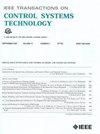Data-Driven Combined Longitudinal and Lateral Control for the Car Following Problem
IF 3.9
2区 计算机科学
Q1 AUTOMATION & CONTROL SYSTEMS
引用次数: 0
Abstract
This article studies the problem of data-driven combined longitudinal and lateral control of autonomous vehicles (AVs) such that the AV can stay within a safe but minimum distance from its leading vehicle and, at the same time, in the lane. Most of the existing methods for combined longitudinal and lateral control are either model-based or developed by purely data-driven methods such as reinforcement learning. Traditional model-based control approaches are insufficient to address the adaptive optimal control design issue for AVs in dynamically changing environments and are subject to model uncertainty. Moreover, the conventional reinforcement learning approaches require a large volume of data, and cannot guarantee the stability of the vehicle. These limitations are addressed by integrating the advanced control theory with reinforcement learning techniques. To be more specific, by utilizing adaptive dynamic programming (ADP) techniques and using the motion data collected from the vehicles, a policy iteration algorithm is proposed such that the control policy is iteratively optimized in the absence of the precise knowledge of the AV’s dynamical model. Furthermore, the stability of the AV is guaranteed with the control policy generated at each iteration of the algorithm. The efficiency of the proposed approach is validated by the integrated simulation of SUMO and CommonRoad.汽车跟随问题的数据驱动纵向和横向联合控制
本文研究了数据驱动的自动驾驶汽车的纵向和横向组合控制问题,使自动驾驶汽车与前车保持最小的安全距离,同时保持在车道内。大多数现有的纵向和横向组合控制方法要么是基于模型的,要么是由纯粹的数据驱动的方法(如强化学习)开发的。传统的基于模型的控制方法难以解决动态变化环境下自动驾驶汽车的自适应最优控制设计问题,且存在模型不确定性。此外,传统的强化学习方法需要大量的数据,并且不能保证车辆的稳定性。通过将先进的控制理论与强化学习技术相结合来解决这些限制。具体而言,利用自适应动态规划(ADP)技术,利用收集到的车辆运动数据,提出了一种策略迭代算法,使控制策略在不知道自动驾驶汽车动力学模型的情况下迭代优化。此外,算法在每次迭代时生成的控制策略保证了AV的稳定性。通过SUMO和CommonRoad的综合仿真验证了该方法的有效性。
本文章由计算机程序翻译,如有差异,请以英文原文为准。
求助全文
约1分钟内获得全文
求助全文
来源期刊

IEEE Transactions on Control Systems Technology
工程技术-工程:电子与电气
CiteScore
10.70
自引率
2.10%
发文量
218
审稿时长
6.7 months
期刊介绍:
The IEEE Transactions on Control Systems Technology publishes high quality technical papers on technological advances in control engineering. The word technology is from the Greek technologia. The modern meaning is a scientific method to achieve a practical purpose. Control Systems Technology includes all aspects of control engineering needed to implement practical control systems, from analysis and design, through simulation and hardware. A primary purpose of the IEEE Transactions on Control Systems Technology is to have an archival publication which will bridge the gap between theory and practice. Papers are published in the IEEE Transactions on Control System Technology which disclose significant new knowledge, exploratory developments, or practical applications in all aspects of technology needed to implement control systems, from analysis and design through simulation, and hardware.
 求助内容:
求助内容: 应助结果提醒方式:
应助结果提醒方式:


